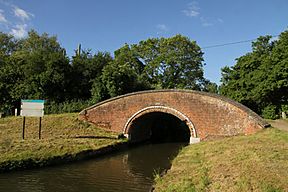Duke's Cut facts for kids
Quick facts for kids Duke's Cut |
|
|---|---|

Bridge 232, crossing the Duke's Cut
|
|
| Location | Wolvercote |
| Country | United Kingdom |
| Coordinates | 51°47′29″N 1°17′48″W / 51.79136°N 1.29675°W |
| Specifications | |
| Length | 0.25 miles (0.40 km) |
| Maximum boat beam | 13 feet 2 inches (4.01 m) |
| Minimum boat draft | 4 feet 11 inches (1.50 m) |
| Locks | 1 |
| Status | Open |
| Navigation authority | Canal and River Trust |
| History | |
| Original owner | Duke of Marlborough |
| Date completed | 1789 |
| Geography | |
| Direction | WSW |
| Start point | Wolvercote Junction, Oxford Canal |
| End point | Duke's Cut Junction, Wolvercote Mill Stream |
| Beginning coordinates | 51°47′33″N 1°17′37″W / 51.7924°N 1.2937°W |
| Ending coordinates | 51°47′27″N 1°17′57″W / 51.7908°N 1.2991°W |
| Branch of | Oxford Canal |
| Connects to | Oxford Canal, Wolvercote Mill Stream |
The Duke's Cut is a small canal in Oxfordshire, England. It connects the Oxford Canal to the River Thames. It does this using a smaller waterway called the Wolvercote Mill Stream. The canal is named after George Spencer, 4th Duke of Marlborough. He owned the land where the canal was built. People often think of it as a branch of the Oxford Canal.
Contents
Why Was Duke's Cut Built?
The Duke of Marlborough asked for this canal to be built. His family had owned the Wolvercote paper mill since 1720. Much of the land around it also belonged to their Blenheim Palace estate.
In the 1790s, the Duke saw a big benefit in bringing coal from Warwickshire to the area. The upper River Thames usually got its coal from far away, via London. This meant there wasn't much left by the time it reached his area.
The Duke knew the land between the Oxford Canal and the mill stream was very flat. This made it perfect for building a waterway. So, he allowed a 500-yard (457-meter) canal to be dug. The mill stream then connected this new canal to the Thames. This also helped boats avoid a difficult old type of lock called a "flash lock."
When Did the Canal Open?
The Duke's Cut opened in 1789. The exact date is not known. However, an advertisement in a local newspaper showed it was open by October 3rd of that year. In 1792, the canal was put into the care of the University of Oxford and the Mayor of Oxford.
What Else Is Near the Cut?
Next to the canal is Duke's Lake. This is a reservoir that people also use for fishing. You can find fish like carp, roach, tench, and bream there.
Today, the Duke's Cut is the most popular way for boats to travel from the Oxford Canal to the Thames. Another route exists through Oxford, using the Isis Lock and the Sheepwash Channel. Before 1937, the Duke's Cut was the only easy way to get between certain parts of the Thames without using a tricky old lock.
How Does Duke's Cut Work?
In 1802, an architect named Robert Mylne looked at the canal. He reported that the Duke's Cut had a stop lock near where it met the Oxford Canal. This lock was about 13 feet 2 inches (4.01 meters) wide.
What Is Duke's Cut Lock?
The lock on Duke's Cut is called Duke's Cut Lock. It is numbered 44A, following the numbering system of the Oxford Canal. The lock gates could be turned around. This meant they could work no matter which waterway had higher water levels. Usually, the canal's water flowed towards the Thames. But during floods, the Thames could rise higher than the canal.
A railway line, the Birmingham and Oxford Junction Railway, crosses over this lock. This railway opened in 1850. In 1987, the lock was given a special status as a Grade II listed building. This means it is an important historical structure.
Bridges and Paths
In 1933, a new road, the Oxford–Witney road, was built. A large bridge was constructed over the Duke's Cut for this road.
The canal also had a path along its north bank for horses to pull boats. This path connected to the Thames and the Oxford Canal's path. Another brick bridge, also Grade II listed, crosses the cut. This bridge carries the towing path of the Oxford Canal.
At the end of the Duke's Cut, there is a special sign. It tells boaters that the Wolvercote Mill Stream beyond that point is only for reaching the mill.

